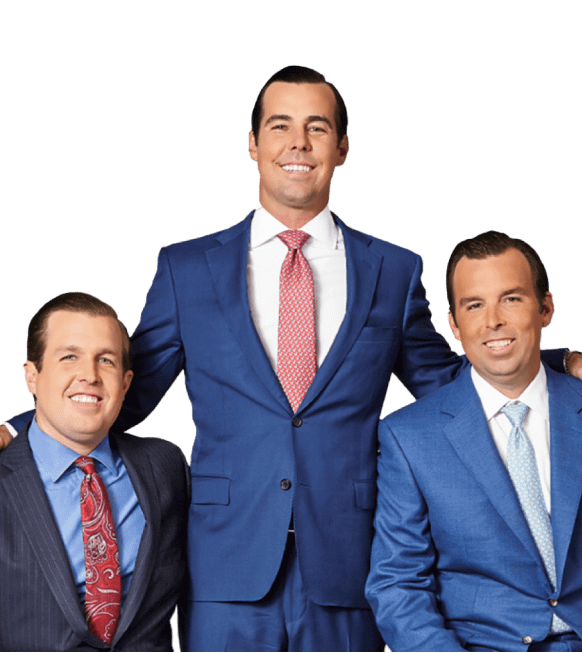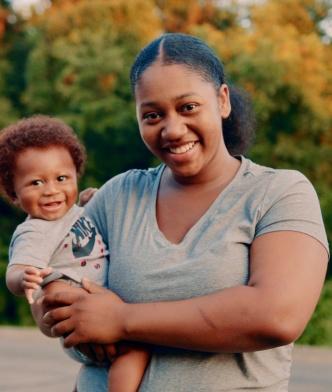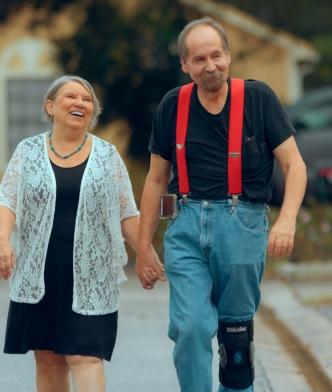Ski Accident Lawyer in New York
Ski Accident Lawyer in New York
350 Fifth Avenue, Suite 6705
New York, NY 10118
Rating Overview
- The Fee Is Free Unless You Win®.
- America's Largest Injury Law Firm™
- Protecting Families Since 1988
- 20 Billion+ Won
- 1,000+ Lawyers Nationwide
Free Case Evaluation

The attorneys featured above are licensed in Florida. For a full list of attorneys in your state please visit our attorney page.
If you or someone you know has been seriously hurt in an accident at a ski resort, your first step should be to seek medical treatment immediately, and your next step should be to speak with a lawyer. Many sky accidents may be the fault of the resort, the manufacturer of your skiing equipment, negligent ski instructors, or many other possible causes for unsafe conditions.
The attorneys at Morgan & Morgan know how easy it is for ski accidents to happen and recognize that victims must often alter their lives as a direct result of coping with these significant challenges. Because of all of the issues involved in the legal process, you need to find a knowledgeable ski accident lawyer in New York, who can help investigate the cause of the accident and determine if and when a ski resort or any other parties could be held responsible for your injuries. A ski accident attorney in New York may be the only person who can help you receive full and fair compensation for your injuries.
To get started, contact Morgan & Morgan for a free, no-obligation case evaluation.
How it works
It's easy to get started.
The Fee Is Free™. Only pay if we win.
Results may vary depending on your particular facts and legal circumstances.
Step 1
Submit
your claimWith a free case evaluation, submitting your case is easy with Morgan & Morgan.
Step 2
We take
actionOur dedicated team gets to work investigating your claim.
Step 3
We fight
for youIf we take on the case, our team fights to get you the results you deserve.
FAQ
Get answers to commonly asked questions about our legal services and learn how we may assist you with your case.
What Happens in the Workplace After a Fight Occurs
Your employer should have both plans to prevent attacks and workplace violence as well as plans for responding in the moment if a fight breaks out.
A sudden attack can also be problematic from the perspective of a thorough investigation. Who started the fight? Were there previous incidents that might have prompted this to happen? All of these are common questions that need to be asked by human resources and they may not have all of the facts of the case or the background unless you're prepared to discuss this. Knowing who will be blamed can also impact the outcome of the case.
If one of the people involved in the fight was the primary attacker and started this entire incident, you need to be prepared to present evidence supporting the same. You might also have grounds to file a lawsuit against the employer if there were reasons that they should have held back this employee from being hired in the first place or from being given as much responsibility or freedom as they have. If the employer should have done a better background check, provided better security or done something else to prevent the attack you may be able to file a lawsuit to recover compensation.
Understanding Liability
There are many different issues of liability that emerge when a fight at work happens. The person who instigated the initial attack could have direct liability for the battery. This can lead to both criminal charges as well as a civil lawsuit against the responsible party. Battery refers to unwelcome touching and any damages that occurred due to that battery, such as lost wages due to missed work, property damage costs or medical expenses associated with treating the injury. This will all be evaluated by a judge in determining whether or not a financial award should apply. This is separate from any criminal charges that may be associated with the battery issue too. If there are any sexual elements associated with the attack, this could carry heavier criminal sentences and be much more serious toward the attacker. Liability doesn't just apply to the alleged attacker.
The employer is another common target in these civil lawsuits when an employee gets seriously hurt at work. You would need to consult with an experienced lawyer to determine what to do if you get into a fight at work. Sharing the specific facts of your case can eliminate you as civil laws that might protect you and some of the evidence you'll need to collect immediately.
Your Action Steps Post Attack
Most people don't know what to do if you get into a fight at work but being prepared to consult with an attorney can lay the groundwork for your next steps. Your employer might have liability when it comes to a few different legal theories. For example, the premises liability theory might expose your employer to being held accountable whether or not the attacker was a customer, employee or someone else. Furthermore, your employer could also be held accountable if the attacker was a person who was on a clock, doing their job for the same employer during the attack. This could also apply in the event that the accident didn't happen in the workplace because of a legal theory that makes employers responsible for acts of their employees while acting in the course of their duty.
You may hear this referred to as respondeat superior. If the employer should have known about the person's propensity to attack or did know about this propensity, and employed this person regardless, this could also create a legal theory around negligent retention or hiring. There are so many different theories of liability that could apply in your case that it's important to hire an attorney who knows what to do if you get into a fight at work.
Discipline
One of the most common issues associated with an attack in the workplace is whether or not discipline will apply to one, both or all parties. All too often the person who was attacked on the job gets disciplined along with the attacker which is very frustrating. This is very true in the event that the attacker is a client or a customer, in which case the employer might downplay the potential consequences and refuse to get the employee the support that they deserve. It can be very complicated to sort through the legal issues of what to do if you get into a fight at work, which is why you need to engage possible outside parties, such as a union representative or a civil attorney. Those who are in non-union workplaces could be disciplined or terminated even if the fight was not their fault. This is because in a right to work state, employees can be terminated by the employer for any reason or for no reason at all. The easiest and path of least resistance for employers is to dismiss everyone who was involved in the fight regardless of whether or not it was their fault. Other forms of discipline outside of termination can also be a challenge for someone hurt in an attack. Blame for the fight might be distributed among numerous different parties which can be very frustrating for someone who believes they were the subject of a one sided attack.
What Should I Do If I Am Attacked at Work?
One of the most important things you can do immediately after an attack happens at work is to contact the police. Your employer might try to defuse the situation or tell you that you don't need to involve outside parties but you need to protect your rights as a victim and get support from the police as soon as possible. Having a police report that shows you contacted them for immediate help can go a long way towards supporting your right to file a claim both in civil and criminal cases. Once you have left the scene and gotten attention for any medical injuries, you need to contact an attorney. Speaking about the specifics of the case as well as any concerns you have about how your employer responded to it will give you a better appraisal of your legal rights in this situation and also help protect you from liability. You need to be guided through the entire legal process when you have been attacked at work and in this serious matter you need to be prepared to fight back.
What Are Employers Responsible For?
Employers must provide a safe working environment for their employees. Employers should be involved in taking any necessary safety precautions to minimize the possibility of attacks at work. It is possible that making other personnel feel safe means firing one or more employees. Employers should also review their existing policies around harassment and attacks to be clear about the consequences. If this is documented in your employee handbook and in company policies what the result will be from an onsite attack, you need to be prepared to hold that employer accountable if they deviate from that.
All employees should be on notice about how fights, physical and verbal, will be handled and when they know what to expect and it's clearly documented in a policy manual will be much less likely to pursue a lawsuit. That being said, employers who deviate from these rules and expose employees to unnecessary risks on the job could be held accountable in the form of a civil lawsuit. Make sure you speak to an experienced attorney about what to do if you get into a fight at work.
Don’t try to handle your case on your own. Outside help can assist you with making sense of difficult and time-sensitive information when a fight that broke out at work left you with injuries.
If you’ve found yourself mixed up in such a situation, contact the experts at Morgan & Morgan today to get a free case evaluation to get started with moving forward from this unfortunate circumstance.
What to Know About Ski Accidents?
Ski accidents happen every winter season in New York state, leading to devastating injuries and sometimes even fatalities. It is well known that skiing is a hazardous activity, and in many cases, injured skiers are personally responsible for their injuries and the accidents that caused them. However, there are some cases in which a resort operator or another skier acting recklessly could be held responsible for ski accident injuries. Ski law is governed by articles 18-101 through 18-108, also known as the safety and skiing code. This requires ski facilities to be maintained properly and to ensure that skiers conduct themselves adequately to minimize the risk of injuries.
What Are the Duties of Ski Operators?
You may not recognize that ski resort owners and ski operators have a responsibility to maintain general safety on their properties. This comes in the form of several different requirements:
- Marking manmade obstructions on ski slopes.
- Making sure that all trail maintenance vehicles have the right warning implements and devices.
- Informing skiers about their responsibilities on colorful and visible signs.
- Holding appropriate safety training prior to every season with employees.
- Expecting open slopes at least twice per day.
- Posting visibly at the entrance of a lift the degree of difficulty of the slopes that that lift goes to.
- To have personnel on site that are appropriately trained around ski activities.
- To develop written policies about how to handle skier reckless conduct.
- To designate personnel who are responsible for implementing that policy.
- To report any injuries or fatalities occurring on the ski resort.
- To maintain ski signage throughout the resort.
What Is the Responsibility of Skiers?
Likewise, skiers also have responsibilities when visiting a ski resort, including:
- Not to ski in a reckless manner.
- To ski only at the limit of their ability.
- To ski only in authorized areas.
- Not to ski on closed slopes.
- Not to damage or vandalize any part of the resort.
- To be familiar with trail information that has been posted for their benefit.
- To follow ski operator directions.
- Not to leave the scene of an accident leading to injuries.
If you have been injured in a serious accident caused by another person's reckless actions at a ski resort, you need to consult with a New York ski accident lawyer as soon as possible. This, in fact, may be the only way for you to recover the compensation needed to put the pieces of your life back together and to enable you to move on effectively into your future. With so much at stake, do not hesitate to consult with a qualified ski accident lawyer in New York as soon as possible after you have been hurt. Working directly with a ski accident lawyer may be your only opportunity to get full and fair compensation and to explain how the accident happened. Your decision to file a personal injury lawsuit could help you to move forward into a more successful future while knowing that your financial bills have been covered by this lawsuit.
Why Do I Really Need an Attorney?
It is not easy to file a lawsuit against a ski resort. Remember that many different ski resorts try to minimize their liability in any and all situations. They will go out of their way to educate you about the possible risks and to ensure that you know the dangers of going forward with ski activities. Furthermore, they may try to dissuade you from filing a lawsuit, even if you have been legitimately hurt directly as a result of their reckless behavior. With these complex factors at play, it is imperative that you have the right attorney to help you. As a ski accident lawyer in New York can inform you, you only have a limited period of time in which to file a lawsuit and failing to file a lawsuit in a timely fashion could block you from the recovery of compensation that you need to put your life back together.
At Morgan & Morgan, we recognize how your life has probably been changed from this significant situation, and we work as hard as possible to represent the best interests of victims. If you're coping with a ski accident in New York and believe that it may have been caused by someone else's negligence or reckless behavior, it is vital that you consult with a qualified attorney immediately. This in fact may be the only opportunity for you to have your case heard and to know that you have done everything possible to protect yourself. There's no doubt that you as well as your family members are dealing with a great deal of stress following a ski accident. But if you discover that the ski accident was caused because a ski resort failed to have the appropriate safety information in place, or that the resort failed to do everything possible to minimize your overall risks, you need to be prepared to move forward with legal help right away.
What are Common Ski Accident Injuries?
The types of injuries that people sustain prior to visiting with a ski accident lawyer in New York will vary depending on the kind of activity they were undertaking at the time. When it comes to Nordic skiing, collarbone fracture, skier's thumb, ankle injuries, knee ligament damage, and shoulder dislocation are the most common. For alpine skiing, sprains, fractures, contusions, and lacerations are the most common. For snowboarding accidents, fractures are the leading injury in the sport, followed by sprains and contusions. For those people undertaking ski boarding activities, 35% of all injuries in that sport are fractures. The knees, lower legs, and ankles are all significantly at risk.
If you were already seriously hurt in a ski accident, there is a good chance you don't remember all of the details leading up to the incident. You may need to rely on other evidence, such as photos, videos, and statements from eyewitnesses to help piece together what ultimately happened. Your primary goal should be to recover as much as possible from your medical injuries, not to worry about the legal aspects of filing your claim. Thankfully, retaining an experienced ski accident lawyer in New York gives you the opportunity to heal as much as you can while also knowing that your rights are being protected in a case.
Getting Legal Help for a Claim
It is not easy to file a lawsuit against a ski resort or an employee working at a ski resort. It can also be very challenging to collect the evidence you need to support your claim if you believe that the ski resort is responsible for your injuries. The sooner that you engage a ski accident attorney in New York, the easier it will be to collect this evidence and to make sure that you have protected your right to recover compensation. You should not have to be alone during this situation and you deserve to have a lawyer who cares about your future and is willing to do everything that is possible to protect your legal right to compensation. Make sure that you retain a legal team who has experience in dealing with ski accidents.
If you're living with the outcome of a ski accident and need more questions answered about your legal rights, contact Morgan & Morgan today for a free, no-obligation case evaluation.






